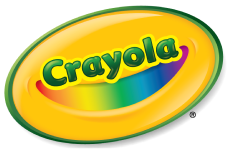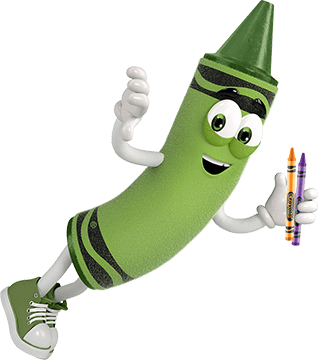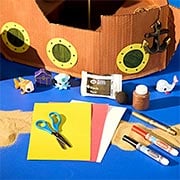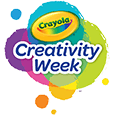Reconociendo la necesidad en las escuelas de crayones de cera seguros y asequibles, Binney & Smith creó la primera caja de ocho lápices de colores Crayola en 1903. Vendida por cinco centavos, esta caja incluía rojo, naranja, amarillo, verde, azul, violeta, marrón y negro.
El nombre Crayola fue acuñado por Alice Binney, esposa del fundador de la empresa, Edwin Binney, y ex maestra de escuela. Combina la palabra francesa para "tiza" ("craie") con "ola", que significa "aceitoso".
¿Quieres saber más sobre nuestra colorida historia? Echa un vistazo a los detalles en la página de historia de Crayola.
Si tienes preguntas adicionales, ¡nos encantaría saber de ti! No dudes en llamarnos o enviarnos un mensaje de texto al 1-800-CRAYOLA días laborables entre las 9 AM y las 4 PM hora del Este. Si prefieres enviarnos un correo electrónico, visita nuestra página de contacto.
Preguntas relacionadas
Explora respuestas a preguntas comunes, consejos útiles para eliminar manchas e ideas creativas para aprovechar al máximo nuestros materiales de arte y recursos gratuitos.
-
Throughout Crayola's history, several crayon colors have been retired, marking significant moments in the evolution of our vibrant palette.
1990
For the first time in Crayola history, eight colors were retired and placed in the Crayola Hall of Fame: blue gray, green blue, lemon yellow, maize, orange red, orange yellow, raw umber, and violet blue. Eight new colors were added: cerulean, dandelion, fuchsia, jungle green, royal purple, teal blue, vivid tangerine, and wild strawberry.2003
Celebrating a century of bringing color to the world, Crayola introduced four new colors named by Crayola fans! To make room for the new hues, we bid farewell to blizzard blue, magic mint, mulberry, and teal blue. The four new colors that were introduced are: inchworm, jazzberry jam, mango tango, and wild blue yonder. Kudos to our hue heroes - the consumers who voted in the "Save the Shade" campaign, ensuring burnt sienna stayed in the pack.2017
To mark National Crayon Day on March 31st, we announced Dandelion was leaving the pack. To honor this iconic color, we sent Dandelion on a retirement tour to his favorite places. His replacement, Bluetiful, was announced on May 5, 2017.Looking for more historical facts about our colorful company? We've got them on the Crayola History page!
-
The wife of the founder of our company, Alice (Stead) Binney, coined the name CRAYOLA Crayons. The name comes from "craie", the French word for chalk, and "ola" from oleaginous. This has been our trademark name since 1903 when our company was founded and remains one of the most important pieces of our heritage. The first box of Crayola Crayons was produced in 1903 as an 8 count box. It sold for a nickel and contained the colors red, orange, yellow, green, blue, violet, brown and black.
-
Before Crayola® Crayons were introduced, we produced black marking crayons in 1900. These early crayons, made with dry carbon black and various waxes, are now known as Staonal® Marking Crayons, widely used in industrial settings.
Recognizing a need in schools for safe and affordable wax crayons, Binney & Smith created the first box of eight Crayola Crayons in 1903. Sold for a nickel, this box included red, orange, yellow, green, blue, violet, brown, and black. The Crayola name was coined by Alice Binney, wife of company founder Edwin Binney and a former schoolteacher. It combines the French word for "chalk" ("craie") with "ola," meaning "oily."
Want to know more about our colorful history? Check out the details at Crayola.com.
-
Yes! We offer a complimentary "Color Your Own" colored pencil chart that can be completed with the Crayola Colored Pencils, 100-count box. Access and print the coloring page on Crayola's Colored Pencil Coloring Page.
-
The basic ingredients contained in Crayola® Crayons are paraffin wax and color pigment. These ingredients are the same for all Crayola Crayon colors, with some modifications in special effects crayons.
Crayola Crayons begin to melt at around 105° Fahrenheit and have a melting point between 120° - 147° Fahrenheit. The melting point is the same for all regular Crayola Crayons; however, the density and amount of pigment included in different crayons will result in varying thickness or viscosity of the mixture.




